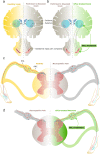Glial cell line-derived neurotrophic factors (GFLs) and small molecules targeting RET receptor for the treatment of pain and Parkinson's disease
- PMID: 32556722
- PMCID: PMC7529621
- DOI: 10.1007/s00441-020-03227-4
Glial cell line-derived neurotrophic factors (GFLs) and small molecules targeting RET receptor for the treatment of pain and Parkinson's disease
Abstract
Rearranged during transfection (RET), in complex with glial cell line-derived (GDNF) family receptor alpha (GFRα), is the canonical signaling receptor for GDNF family ligands (GFLs) expressed in both central and peripheral parts of the nervous system and also in non-neuronal tissues. RET-dependent signaling elicited by GFLs has an important role in the development, maintenance and survival of dopamine and sensory neurons. Both Parkinson's disease and neuropathic pain are devastating disorders without an available cure, and at the moment are only treated symptomatically. GFLs have been studied extensively in animal models of Parkinson's disease and neuropathic pain with remarkable outcomes. However, clinical trials with recombinant or viral vector-encoded GFL proteins have produced inconclusive results. GFL proteins are not drug-like; they have poor pharmacokinetic properties and activate multiple receptors. Targeting RET and/or GFRα with small molecules may resolve the problems associated with using GFLs as drugs and can result in the development of therapeutics for disease-modifying treatments against Parkinson's disease and neuropathic pain.
Keywords: Drug design; Drug development; GDNF family ligands (GFLs); Glial cell line-neurotrophic factor (GDNF); Neurturin (NRTN); RET agonist; RET receptor tyrosine kinase; RET receptor, artemin (ARTN); Small molecule.
Conflict of interest statement
Dr. Sidorova is a minor shareholder in GeneCode Ltd., a company owning IPRs for RET agonists from the BT13 family. The other author declares that he has no competing interests.
Figures


Similar articles
-
Small Molecules and Peptides Targeting Glial Cell Line-Derived Neurotrophic Factor Receptors for the Treatment of Neurodegeneration.Int J Mol Sci. 2020 Sep 8;21(18):6575. doi: 10.3390/ijms21186575. Int J Mol Sci. 2020. PMID: 32911810 Free PMC article. Review.
-
[Glial cell line-derived neurotrophic factor family ligands and their therapeutic potential].Mol Biol (Mosk). 2016 Jul-Aug;50(4):589-598. doi: 10.7868/S0026898416040108. Mol Biol (Mosk). 2016. PMID: 27668599 Russian.
-
Novel RET agonist for the treatment of experimental neuropathies.Mol Pain. 2020 Jan-Dec;16:1744806920950866. doi: 10.1177/1744806920950866. Mol Pain. 2020. PMID: 32811276 Free PMC article.
-
Functional mapping of receptor specificity domains of glial cell line-derived neurotrophic factor (GDNF) family ligands and production of GFRalpha1 RET-specific agonists.J Biol Chem. 2000 Feb 4;275(5):3412-20. doi: 10.1074/jbc.275.5.3412. J Biol Chem. 2000. PMID: 10652334
-
Structural studies of GDNF family ligands with their receptors-Insights into ligand recognition and activation of receptor tyrosine kinase RET.Biochim Biophys Acta. 2013 Oct;1834(10):2205-12. doi: 10.1016/j.bbapap.2012.10.008. Epub 2012 Oct 17. Biochim Biophys Acta. 2013. PMID: 23085183 Review.
Cited by
-
A network map of GDNF/RET signaling pathway in physiological and pathological conditions.J Cell Commun Signal. 2023 Sep;17(3):1089-1095. doi: 10.1007/s12079-023-00726-1. Epub 2023 Jan 30. J Cell Commun Signal. 2023. PMID: 36715855 Free PMC article.
-
Association of Gene Expression Profiles in HPV-Positive Head and Neck Squamous Cell Carcinoma with Patient Outcome: In Search of Prognostic Biomarkers.Int J Mol Sci. 2025 Jun 19;26(12):5894. doi: 10.3390/ijms26125894. Int J Mol Sci. 2025. PMID: 40565370 Free PMC article.
-
Recent developments in nucleic acid-based therapies for Parkinson's disease: Current status, clinical potential, and future strategies.Front Pharmacol. 2022 Oct 20;13:986668. doi: 10.3389/fphar.2022.986668. eCollection 2022. Front Pharmacol. 2022. PMID: 36339626 Free PMC article. Review.
-
Multifaceted Roles of ALK Family Receptors and Augmentor Ligands in Health and Disease: A Comprehensive Review.Biomolecules. 2023 Oct 7;13(10):1490. doi: 10.3390/biom13101490. Biomolecules. 2023. PMID: 37892172 Free PMC article. Review.
-
Effects of glial-derived neurotrophic factor on remodeling and mitochondrial function in human airway smooth muscle cells.Am J Physiol Lung Cell Mol Physiol. 2024 Nov 1;327(5):L684-L693. doi: 10.1152/ajplung.00101.2024. Epub 2024 Sep 24. Am J Physiol Lung Cell Mol Physiol. 2024. PMID: 39316680
References
-
- Airaksinen MS, Saarma M. The GDNF family: signalling, biological functions and therapeutic value. Nat Rev Neurosci. 2002;3:383–394. - PubMed
-
- Åkerud P, Holm PC, Castelo-Branco G, et al. Persephin-overexpressing neural stem cells regulate the function of nigral dopaminergic neurons and prevent their degeneration in a model of Parkinson’s disease. Mol Cell Neurosci. 2002;21:205–222. - PubMed
Publication types
MeSH terms
Substances
Grants and funding
LinkOut - more resources
Full Text Sources
Medical

